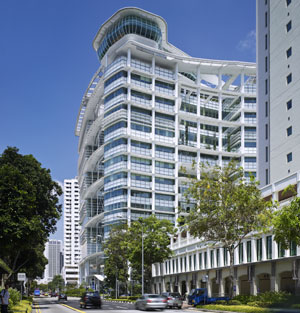T. R. Hamzah & Yeang
T.R. Hamzah & Yeang applies its trademark bioclimatic design principles to the new National Library in Singapore
Photo © Tim Griffith

By Clifford A. Pearson
Ken Yeang has been preaching the green gospel for more than 30 years. When he returned to his native Malaysia after school in England, he started designing modern buildings that worked with the local climate instead of merely fighting it with airtight envelopes and lots of air-conditioning—buildings such as the Menara Mesiniaga [RECORD, March 1993, Pacific Rim section, page 26] and the Guthrie Pavilion [record, August 1998, page 81]. With his new National Library in Singapore, he has applied all this expertise to a building type often seen as resistant to energy-saving design and, in the process, has created a civic icon for a city-state bent on leveraging knowledge as an economic engine.
At first glance, the building seems to be trying a bit too hard to impress, with a sweeping facade on the east, a vast array of projecting blades and shelves, and a UFO-shaped viewing pavilion hovering above the roof. But these moves help animate what could have been a large, squat building—630,000 square feet and only 16 stories high. And by carving deep recesses and skycourts into the white blocky form, the architect creates a lively play of shadow and light that not only pleases the eye but offers cool spaces for people using the building.
When the National Library Board of Singapore held a design competition for the project in 1998, it didn’t ask for a green building. As the Singapore economy has shifted in recent years from an industrial base to one driven by information technologies and services, the government has undertaken the construction of sprawling educational campuses, some designed by high-profile international architects such as James Stirling/Michael Wilford [record, May 1997, page 102] and Gwathmey Siegel [record, December 2001, page 92]. Now it is trying to add a cultural layer to an urban mix that had previously emphasized shopping and eating as the island nation’s primary spare-time activities.
Yeang’s competition entry pulled the building into two separate parts—a banana-shaped structure on the east for exhibition spaces and cultural activities and a blockier structure on the west that would house the library collections and reading rooms. A tall atrium or semienclosed “street” would run between the two pieces, with bridges at the upper levels connecting the two sides. By raising the collections block one story off the ground, Yeang created a covered plaza at ground level that offers a large, shaded space for an outdoor café and all kinds of public events, such as book fairs and dance performances.
GREEN FEATURES
Architecturally, the Library has a number of prominent active and passive design features such as:
A naturally ventilated public plaza on Level 1, ie the Plaza.
Fully double glazed façade with low (heat) emissivity glass.
Daylight sensors at the perimeter of the library areas that allow the lights to dim or switch off depending on the amount of natural light entering the building.
Fixed sunshades that ensure direct sunlight does not enter the building during most of the day, thereby reducing the cooling load on the air conditioning systems.
Automatic Blinds installed along the Victoria Street façade that are automatically activated in the evenings when the sun is low and fixed shades are ineffective.
Rain Sensor installed as part of the automatic irrigation system, saving on both water and power consumption.
Motion Detectors in staff toilets that switch on and off automatically when occupied.
Integrated Lighting Control System that allows strategic programming of the internal and external lights. This helps to control the building's energy consumption. In addition, localized intelligent switches for the office floor provides after hours lighting only when required at the occupied areas.
The Carbon Monoxide (CO) Monitoring system in the car park is programmed to operate during the morning and evening peak hours through the Building Management System. During these times, the CO sensors activate the fans when levels exceed 15 ppm.
The building is equipped with an integrated Building Management System (BMS), which monitors and controls the mechanical and electrical (M&E) equipment, optimising the operation of the systems.
The Variable Air Volume (VAV) terminal units of the Air-Conditioning and Mechanical Ventilation (ACMV) System means that the air volume supplied to each space is optimised to maintain the specified temperature in the building. Carbon Dioxide sensors also ensure that the percentage of fresh air is maintained in all areas.
High efficiency chillers of 0.61 kw/RT are configured with larger non-essential centrifugal chillers and smaller essential screw chillers. The latter also functions as the night load chiller as well as a swing chiller in the day. This configuration ensures that the chiller plant is always running at its optimum levels.
Variable speed drives (VSDs) have been employed on the air handling units (AHUs) and pumps. VSDs allow the building loads to be accurately matched and ensure the systems consume less energy during part load conditions.
Due to the tropical climate and the hygroscopic nature of the books in the library, the internal environment needs to be continuously controlled. To save on energy, a night setback strategy is employed. This strategy results in a higher temperature in the building outside of operating hours. This helps to reduce the energy consumption of the chiller plant during this period. Also, by employing such a strategy, less energy is needed to bring the building to the optimum temperature during the occupied periods.
An energy analysis study was conducted to establish the most efficient method of operating the escalators in the building. Based on this study the escalators have been installed with sensors, which detect pressure and operates only when someone uses them.
Copyright (C)2006 National Library Board, Singapore
Không có nhận xét nào:
Đăng nhận xét